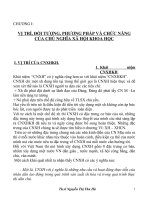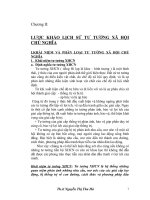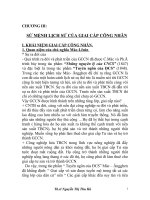SLEEP NEEDS, PATTERNS,AND DIFFICULTIESOF ADOLESCENTS doc
Bạn đang xem bản rút gọn của tài liệu. Xem và tải ngay bản đầy đủ của tài liệu tại đây (267.15 KB, 62 trang )
Forum on Adolescence
Mary G. Graham,
Editor
Board on Children, Youth, and Families
Commission on Behavioral and Social Sciences and Education
National Research Council
and
Institute of Medicine
NATIONAL ACADEMY PRESS
Washington, D.C.
SUMMARY OF A WORKSHOP
SLEEP NEEDS
,
PATTERNS
,
AND
DIFFICULTIES
OF
ADOLESCENTS
NATIONAL ACADEMY PRESS 2101 Constitution Avenue, N.W. Washington, D.C. 20418
NOTICE: The project that is the subject of this report was approved by the
Governing Board of the National Research Council, whose members are drawn from
the councils of the National Academy of Sciences, the National Academy of Engineer-
ing, and the Institute of Medicine. The members of the committee responsible for the
report were chosen for their special competences and with regard for appropriate
balance.
The study was supported by Grant No. 2925-003 between the National Academy
of Sciences and Carnegie Corporation of New York and Grant No. 5294-158 between
the National Academy of Sciences and the National Institute on Child Health and
Human Development, U.S. Department of Health and Human Services. Any opinions,
findings, conclusions, or recommendations expressed in this publication are those of
the author(s) and do not necessarily reflect the views of the organizations or agencies
that provided support for this project.
International Standard Book Number 0-309-07177-1
Additional copies of this report are available from the National Academy Press, 2101
Constitution Avenue, N.W., Lock Box 285, Washington, D.C. 20055.
Call (800) 624-6242 or (202) 334-3313 (in the Washington metropolitan area)
This report is also available online at
Printed in the United States of America
Copyright 2000 by the National Academy of Sciences. All rights reserved.
Suggested citation: National Research Council and Institute of Medicine (2000) Sleep
Needs, Patterns, and Difficulties of Adolescents. Forum on Adolescence. Mary G.
Graham, ed. Board on Children, Youth, and Families, Commission on Behavioral
and Social Sciences and Education. Washington, D.C.: National Academy Press.
The National Academy of Sciences is a private, nonprofit, self-perpetuating society of
distinguished scholars engaged in scientific and engineering research, dedicated to the
furtherance of science and technology and to their use for the general welfare. Upon
the authority of the charter granted to it by the Congress in 1863, the Academy has a
mandate that requires it to advise the federal government on scientific and technical
matters. Dr. Bruce M. Alberts is president of the National Academy of Sciences.
The National Academy of Engineering was established in 1964, under the charter of
the National Academy of Sciences, as a parallel organization of outstanding engineers.
It is autonomous in its administration and in the selection of its members, sharing with
the National Academy of Sciences the responsibility for advising the federal govern-
ment. The National Academy of Engineering also sponsors engineering programs
aimed at meeting national needs, encourages education and research, and recognizes
the superior achievements of engineers. Dr. William A. Wulf is president of the
National Academy of Engineering.
The Institute of Medicine was established in 1970 by the National Academy of
Sciences to secure the services of eminent members of appropriate professions in the
examination of policy matters pertaining to the health of the public. The Institute acts
under the responsibility given to the National Academy of Sciences by its congressional
charter to be an adviser to the federal government and, upon its own initiative, to
identify issues of medical care, research, and education. Dr. Kenneth I. Shine is
president of the Institute of Medicine.
The National Research Council was organized by the National Academy of Sciences
in 1916 to associate the broad community of science and technology with the
Academy’s purposes of furthering knowledge and advising the federal government.
Functioning in accordance with general policies determined by the Academy, the
Council has become the principal operating agency of both the National Academy of
Sciences and the National Academy of Engineering in providing services to the govern-
ment, the public, and the scientific and engineering communities. The Council is
administered jointly by both Academies and the Institute of Medicine. Dr. Bruce M.
Alberts and Dr. William A. Wulf are chairman and vice chairman, respectively, of the
National Research Council.
National Academy of Sciences
National Academy of Engineering
Institute of Medicine
National Research Council
FORUM ON ADOLESCENCE
1999-2000
DAVID A. HAMBURG (Chair), Carnegie Corporation of New York
(President Emeritus)
HUDA AKIL, Mental Health Research Institute, University of Michigan,
Ann Arbor
CHERYL ALEXANDER, Center for Adolescent Health, Johns Hopkins
University
CLAIRE BRINDIS, Institute for Health Policy Studies, Division of
Adolescent Medicine, University of California, San Francisco
GREG DUNCAN, Institute for Policy Research, Northwestern
University
JACQUELYNNE ECCLES, School of Education, University of
Michigan, Ann Arbor
ABIGAIL ENGLISH, Center for Adolescent Health & the Law, Chapel
Hill, North Carolina
EUGENE GARCIA, School of Education, University of California,
Berkeley
HELENE KAPLAN, Skadden, Arps, Slate, Meagher, and Flom,
New York
IRIS F. LITT, Division of Adolescent Medicine, Stanford University
JOHN MERROW, The Merrow Report, New York
ANNE C. PETERSEN, W.K. Kellogg Foundation, Battle Creek,
Michigan
KAREN PITTMAN, International Youth Foundation, Baltimore
ANNE PUSEY, Jane Goodall Institute’s Center, University of Minnesota
MICHAEL RUTTER, Institute of Psychiatry, University of London
STEPHEN A. SMALL, Department of Child and Family Studies,
University of Wisconsin, Madison
CAMILLE ZUBRINSKY CHARLES, Department of Sociology,
University of Pennsylvania
BARUCH FISCHHOFF (Liaison, IOM Council ), Social and Decision
Sciences, Carnegie Mellon University
ELEANOR E. MACCOBY (Liaison, Commission on Behavioral and Social
Sciences and Education), Department of Psychology (emeritus),
Stanford University
v
vi
Michele D. Kipke, Director
Mary Graham, Associate Director, Dissemination and Communications
Amy Gawad, Senior Project Assistant
Elena Nightingale, Scholar-in-Residence
vii
BOARD ON CHILDREN, YOUTH, AND FAMILIES
1999-2000
JACK P. SHONKOFF (Chair), Heller Graduate School, Brandeis
University
EVAN CHARNEY (Vice Chair), Department of Pediatrics, University of
Massachusetts
JAMES A. BANKS, Center for Multicultural Education, University of
Washington
SHEILA BURKE, John F. Kennedy School of Government, Harvard
University
DAVID CARD, Department of Economics, University of California,
Berkeley
DONALD COHEN, Yale-New Haven Children’s Hospital,
Yale University
MINDY FULLILOVE, Columbia University
KEVIN GRUMBACH, Department of Family and Community
Medicine, Primary Care Research Center, University of California,
San Francisco
MAXINE HAYES, Department of Community and Family Health,
Washington State Department of Health
MARGARET HEAGARTY, Department of Pediatrics, Harlem Hospital
Center, Columbia University
RENEE JENKINS, Department of Pediatrics and Child Health,
Howard University
SHEILA KAMERMAN, School of Social Work, Columbia University
HARRIET KITZMAN, School of Nursing, University of Rochester
SANDERS KORENMAN, School of Public Affairs, Baruch College
CINDY LEDERMAN, Circuit Court, Juvenile Justice Center, Dade
County, Florida
SARA McLANAHAN, Office of Population Research, Princeton
University
VONNIE McLOYD, Center for Human Growth and Development,
University of Michigan
PAUL NEWACHECK, Institute of Health Policy Studies and
Department of Pediatrics, University of California, San Francisco
GARY SANDEFUR, Department of Sociology, University of Wisconsin,
Madison
viii
RUTH STEIN, Department of Pediatrics, Albert Einstein College of
Medicine
PAUL WISE, Department of Pediatrics, Boston Medical Center
RUTH T. GROSS (Liaison, IOM Board on Health Promotion and Disease
Prevention), Professor of Pediatrics (emeritus), Stanford University
ELEANOR E. MACCOBY (Liaison, Commission on Behavioral and Social
Sciences and Education), Department of Psychology (emeritus),
Stanford University
WILLIAM ROPER (Liaison, IOM Council ), Institute of Medicine,
University of North Carolina, Chapel Hill
Michele D. Kipke, Director
Mary Graham, Associate Director, Dissemination and Communications
Mary Strigari, Administrative Associate
Elena Nightingale, Scholar-in-Residence
ix
Contents
PREFACE xi
I
NTRODUCTION 1
A
DOLESCENT DEVELOPMENT AND SLEEP 3
A
DOLESCENT SLEEP PATTERNS AND DAYTIME SLEEPINESS 4
C
ONSEQUENCES OF INSUFFICIENT SLEEP 13
I
DENTIFYING AND INTERVENING IN CLINICAL SLEEP PROBLEMS 18
C
HANGING SCHOOL STARTING TIMES 23
E
DUCATING THE PUBLIC ABOUT ADOLESCENT SLEEP NEEDS 25
N
EXT STEPS 26
R
EFERENCES 31
O
THER INFORMATION RESOURCES 34
A
PPENDIX: WORKSHOP AGENDA AND PARTICIPANTS 35
S
ELECTED REPORTS OF THE BOARD ON CHILDREN, YOUTH, AND FAMILIES 46
xi
Preface
This report summarizes the presentations and discussion at a work-
shop entitled Sleep Needs, Patterns, and Difficulties of Adolescents, held
on September 22, 1999. The workshop was organized by the Board on
Children, Youth, and Families and the Forum on Adolescence of the Na-
tional Research Council and Institute of Medicine, with funding from the
Carnegie Corporation of New York and the National Institute on Child
Health and Human Development, U.S. Department of Health and Hu-
man Services.
The workshop brought together policy makers, researchers, and prac-
titioners to examine research on adolescence and sleep. Among the ques-
tions it addressed were: How much sleep do teenagers need? What are the
typical sleep patterns of adolescents? What are the influences on sleep
problems and disturbances? What are the consequences of insufficient sleep?
Drawing on participants’ presentations and discussions, this workshop sum-
mary addresses each of these questions. Of necessity, it reflects the particu-
lar emphases of the workshop discussions as well as specific statements made
by participants during the workshop.
It is important to note that this workshop was an effort intended to
take stock of the current knowledge base on adolescent sleep and to high-
light key findings from research. Given the limitations of both time and
scope, the workshop could not address all issues that are important in this
area. For example, the workshop did not explore in depth the social and
cultural contexts that influence adolescents and their behavior.
xii PREFACE
It is also important to note that this workshop report summarizes ma-
terial presented and discussed at the workshop. Although it references pub-
lished materials suggested or provided by participants, it is not intended to
provide a comprehensive or thorough review of the field. It is our hope
that this report will illuminate important issues related to sleep and the
well-being of adolescents that deserve further attention and consideration.
This report has been reviewed in draft form by individuals chosen for
their diverse perspectives and technical expertise, in accordance with proce-
dures approved by the Report Review Committee of the National Research
Council. The purpose of this independent review is to provide candid and
critical comments that will assist the institution in making the published
report as sound as possible and to ensure that the report meets institutional
standards for objectivity, evidence, and responsiveness to the study charge.
The review comments and draft manuscript remain confidential to protect
the integrity of the deliberative process.
We thank the following individuals for their participation in the re-
view of this report: Missy Fleming, Child and Adolescent Health, Ameri-
can Medical Association, Chicago, IL; Anthony Jackson, Disney Learning
Partnership, Walt Disney Corporation, Burbank, CA; Reed Larson, De-
partment of Human and Community Development, University of Illinois,
Champaign/Urbana; Richard MacKenzie, Division of Adolescent Medi-
cine, Children’s Hospital, Los Angeles, CA; Barbara McNeil, Department
of Health Care Policy, Harvard Medical School; and Shepherd Smith, In-
stitute for Youth Development, Sterling, VA.
Although the individuals listed above provided constructive comments
and suggestions, it must be emphasized that responsibility for the
final content of this report rests entirely with the authoring group and the
institution.
David Hamburg
Chair, Forum on Adolescence
SLEEP NEEDS
,
PATTERNS
,
AND
DIFFICULTIES
OF
ADOLESCENTS
1
Sleep Needs, Patterns, and
Difficulties of Adolescents
INTRODUCTION
Sleep is not only a biological necessity but also a physiological drive.
In today’s fast-paced world, though, a good night’s sleep is often the first
thing to go. The effects of inadequate sleep are more than mere annoy-
ances: they affect our mood and how we perform at school, work, and
home and behind the wheel. Lost sleep also accumulates over time; the
more “sleep debt” an individual incurs, the greater the negative conse-
quences, according to researchers in the field (Carskadon and Dement,
1981; Wolfson and Carskadon, 1998).
Research on adolescents and sleep has been under way for more than
two decades, and there is growing evidence that adolescents are develop-
mentally vulnerable to sleep difficulties. To discuss current research in this
area and its implications in the policy, public, health, and educational are-
nas, the Forum on Adolescence of the Board on Children, Youth, and Fami-
lies held a workshop, entitled Sleep Needs, Patterns, and Difficulties of
Adolescents, on September 22, 1999. Both the board and the forum are
initiatives of the Institute of Medicine and the National Research Council
of the National Academies.
The workshop brought together researchers, educators, health care pro-
viders, and policy makers to review current findings on adolescent sleep.
More than 100 individuals attended the workshop, including medical re-
searchers, teachers, parents, and young people themselves. David A. Ham-
2 SLEEP NEEDS, PATTERNS, AND DIFFICULTIES OF ADOLESCENTS
burg, chair of the Forum on Adolescence, and William C. Dement, direc-
tor of the Sleep Disorders Center at Stanford University, cochaired the
meeting. As Hamburg noted in his opening remarks, the workshop offered
an “opportunity to call attention to a very important and, until recently,
neglected problem area.” “Adolescence is the time of greatest vulnerability
from the standpoint of sleep,” Dement, a pioneer in the field of sleep re-
search, told workshop participants. Counterproductive adolescent sleep
patterns tend to be viewed as part of the culture of the teenage years. But
according to Dement and other researchers, the need for sleep does not
decrease as individuals go through adolescence (Carskadon, 1982). The
amount of sleep that adolescents get drops precipitously, however, making
it very difficult for them to avoid chronic sleep loss.
Dement asked the workshop participants to consider several questions:
How much sleep do adolescents require? What factors contribute to sleep
loss in adolescence? What are the consequences of chronic sleep loss in
young people? What can be done about it?
Through presentations and panel discussions, workshop participants
addressed these questions. They summarized results from research over the
past two decades on issues such as how much sleep teenagers need and how
much they typically get, the sleep patterns of adolescents, and the factors—
biological, behavioral, and environmental—that influence them. They dis-
cussed recent efforts to facilitate meeting the sleep needs of adolescents,
including consideration of later starting times for high schools and efforts
to educate the public, including parents and youth, on the importance of
adequate sleep. Workshop participants acknowledged the complexity of
the issue and observed that additional research on the causes and conse-
quences of adolescent sleep problems is appropriate. Assessing the impact
and effects of changes in policy and practices by educators, parents, and
youth themselves, as well as increased public understanding of the dimen-
sions of the problem, also could advance the search for remedies.
Drawing on workshop participants’ presentations and subsequent ques-
tion and answer sessions, this report summarizes key themes that emerged
from the day’s discussions. It is intended as an overview of the issues dis-
cussed for an audience of educators, parents, youth, health care providers,
and other interested readers. It is not intended to provide a comprehensive
review of findings from the entire field of research on adolescent sleep. Of
necessity, the report reflects the content and emphases of the presentations
and discussions. It therefore does not provide full details on research meth-
SUMMARY OF A WORKSHOP 3
ods and samples or a critical analysis of the strengths and weaknesses of the
studies discussed.
It is important to note that workshop participants agreed that adoles-
cent sleep needs and difficulties are complex issues for which there is no
single solution. Because the factors that influence adolescent sleep patterns
are both biological and behavioral, solutions need to address those pro-
cesses as well as the constraints on sleep imposed by the practicalities and
habits of young people’s daily lives. Additional research is appropriate on a
number of topics, as outlined later in this report. Research can also further
understanding of the links between sleep difficulties and such outcomes as
poor school performance, as well as the extent to which biological rhythms
affect sleep patterns in teenagers. Viewing adolescent sleep problems from
a public health perspective suggests that public education programs and
social marketing campaigns related to other health concerns may provide
models appropriate in this area as well.
ADOLESCENT DEVELOPMENT AND SLEEP
To provide a background for examining the sleep problems of young
people, Robert Blum, professor and director of General Pediatrics and Ado-
lescent Health at the University of Minnesota, reviewed recent research on
adolescent development, highlighting new ways of looking at developmen-
tal stages. He noted that, historically, adolescent development has been
looked at as a discrete phenomenon. Today, that has changed and adoles-
cent development is understood to be heavily influenced by the contexts
within which young people live. In short, young people adapt to their
environment as the environment adapts to them.
Puberty is a transitional period between childhood and adulthood.
During this time of growth and change, young people begin to develop
adult reproductive capabilities and their organ systems undergo dramatic
changes. The timing of puberty is extremely variable. For boys the age of
onset is between 9 and 15, whereas girls may experience puberty at 8 to 16
years of age (National Research Council and Institute of Medicine, 1999).
The age of pubertal onset shifted downward in the 20th century in North
America and Europe, due in part to public health factors such as improved
sanitation and better nutrition.
Accompanying these dramatic physical changes are shifts in cognitive
development. During this period, adolescents move from a child’s trial-
and-error approach to problem solving to more abstract reasoning and skills.
4 SLEEP NEEDS, PATTERNS, AND DIFFICULTIES OF ADOLESCENTS
Completing a puzzle, for example, is likely to be done first by arranging
pieces mentally before moving them on the board. Adolescents grow in
language sophistication as well, as they begin to grasp multiple meanings of
words—for example, puns and double entendres.
During puberty, young people also begin to understand and engage
the world differently, shifting gradually from egocentrism to mutuality.
With the development of mature social cognition comes the capacity to
read social cues, to infer what people are thinking based on not only lan-
guage but also nonverbal signals. This is seen very dramatically at about
seventh grade, when young people start becoming socially savvy. For those
who fail to develop this capability, the consequence can mean social isola-
tion.
All these changes take place in particular environments—family, com-
munity, social—some of which may promote healthy development and
others may predispose adolescents to risk. Research on resilience and pro-
tective factors, for example, shows that parental connectedness enhances
and promotes healthy development in adolescents. Findings also indicate
that having fewer children and spacing births two or more years apart pro-
vides greater opportunity for family interaction, Blum said. Parental men-
tal health is a significant influence, particularly if there is a history of sub-
stance abuse or psychiatric hospitalization. Conflict within the family
undermines the security of the home as a place for positive development.
“Children need a safe and secure base,” Blum said. “There are two places
where they can get this: at home or at school. If neither provides safety and
security, the potential for trouble exists.”
Blum noted that policies also have an influence—policies related to
youth employment, for example. Research indicates that working more
than 20 hours a week during the school year is associated with a variety of
unhealthy and problem behaviors in youth, including substance abuse, in-
sufficient sleep, and limited time spent with families (National Research
Council and Institute of Medicine, 1999). Understanding the influence of
various policies, including school starting times, is important to the discus-
sion of adolescent sleep issues as well.
ADOLESCENT SLEEP PATTERNS AND
DAYTIME SLEEPINESS
Workshop participants heard from a panel of researchers who reviewed
findings from the United States and abroad on sleep patterns and problems
SUMMARY OF A WORKSHOP 5
in adolescents. They discussed findings indicating that the factors contrib-
uting to teenagers’ sleep loss lie in both the biological and the social realms.
Mary A. Carskadon, director of the E. P. Bradley Hospital Sleep Re-
search Laboratory and professor in the Department of Psychiatry and Hu-
man Behavior, Brown University School of Medicine, noted several major
trends in adolescent sleep patterns. Data from cross-sectional surveys of
students show that, from ages 10 to 17, students’ self-reported bedtimes
become later and later, on both weekdays and weekends (Carskadon, 1990;
Wolfson and Carskadon, 1998). In middle adolescence, rising times be-
come earlier during the week, due largely to school starting times. High
school starting times, which typically are earlier than those of middle and
elementary schools, have moved to even earlier hours in recent years. Many
begin at or before 7:30 a.m., largely due to the timing and availability of
school buses. Thus, while sleep needs remain unchanged, Carskadon said,
adolescents are spending less time sleeping, and alterations in sleep sched-
ules during the week compared with those on the weekend are becoming
more pronounced. This is in sharp contrast to the stable pattern of sleep
found in younger children, who get the same amount of sleep during the
week as on weekends—an average of 10 hours a night, Carskadon noted.
The effects of restricted sleep on sleep structure, mood, and perfor-
mance in children and young people have been evaluated under different
conditions (Carskadon and Dement, 1981). In a longitudinal study of
sleep and sleepiness in young people, researchers assessed children in a sum-
mer “sleep camp” laboratory at Stanford University (Carskadon, 1982).
Researchers began studying the children when they were 10 to 12 years of
age and followed them every summer for 4 to 6 years. Researchers mea-
sured their sleep according to the Multiple Sleep Latency Test (MSLT), a
standard measure of sleepiness; the test is administered at designated peri-
ods throughout the day to determine the time it takes subjects to fall asleep
(Carskadon et al., 1986).
In the laboratory the young study subjects wore electrodes that gauged
their physiological reactions in sleep and while they were awake. Each
night they had the same 10-hour window of time available for sleep, with
sleep latency—the time it takes to fall asleep—tested throughout the day at
2-hour intervals. Starting with the hypothesis that the amount of sleep
needed would decrease with age to a typical adult 7.5 hours a night, the
study assessed the youngsters at various stages of pubertal development to
shed light on the issue of sleep needs.
The results showed that the younger children slept 9 hours and 20
6 SLEEP NEEDS, PATTERNS, AND DIFFICULTIES OF ADOLESCENTS
minutes on average and awoke spontaneously. As they progressed through
adolescence, they continued to get the same amount of sleep, but they no
longer woke spontaneously before the end of the sleep window. At
midpuberty, adolescents also became sleepier during the day. According to
the MSLT, prepubertal and early adolescents were unable to fall asleep in
the daytime, but at midpuberty, even with 9 hours and 20 minutes of sleep,
daytime drowsiness appeared and worsened. These older adolescents
struggled to stay awake throughout the day, whereas the younger adoles-
cents had no problem at all.
A sleep habits survey administered to more than 3,000 Rhode Island
9th to 12th graders revealed that the median amount of reported sleep in
this group was 7.5 hours (Wolfson and Carskadon, 1998). A quarter of
these students reported sleeping 6.5 hours or less. For two-thirds of the
students, bedtime was after 11 p.m. on school nights; 91 percent rose at
6:30 a.m. or earlier. Seventy percent of the teenagers delayed both bedtime
and wake-up time by an hour or more on weekends to try to catch up on
their sleep. Sleeping late on Saturday and Sunday, however, usually fosters
a later sleep onset on Sunday night. Despite this, sleeping in on weekends
allows adolescents to pay back some of their weeknight sleep debt, some
workshop participants observed.
Influences on Adolescent Sleep Patterns
The various factors that influence how much adolescents sleep cluster
into two major areas. One is intrinsic—the biological processes going on
internally in adolescents; the other is the external factors—social, academic,
and environmental—that play a significant role in their sleep habits.
Intrinsic Factors
Internal processes themselves fall into two types. One is the biological
timing system—the circadian rhythms of approximately 24-hour intervals
that influence when and how much we sleep. The second is the internal
system that tallies the balance of sleeping and waking—the sleep/wake ho-
meostasis system: when sleep is deprived, more sleep is needed. Thus, as
discussed at the workshop, “sufficient” sleep can be defined as the amount
that satisfies the homeostatic process and is not associated with daytime
sleepiness. This is analogous to the daily caloric requirement to maintain a
stable weight.
SUMMARY OF A WORKSHOP 7
Research findings suggest that changes occur in the “biological clock”
during adolescence. As a result, teenagers have a natural tendency to fall
asleep later and to wake up later. This is referred to as sleep phase delay.
Carskadon described research on college students that restricted their sleep
to 5 hours a night for several nights. This study found that daytime sleepi-
ness increased with each night of restricted sleep, indicating the cumulative
effect of sleep loss. The research also showed that even with restricted sleep
students felt more alert in the evening, encouraging the tendency to stay up
late again (Carskadon and Dement, 1981). If additional tests of sleep la-
tency are carried out at 8 and 10 p.m., a student who struggled and dozed
through the early afternoon becomes energetic and internally stimulated in
the evening, often past midnight.
Another study that looked at the effects of the biological clock did so
by examining melatonin secretion. As night falls, melatonin is “turned
on,” preparing the body for sleep. Toward dawn, it shuts off, as cortisol
secretion increases. Carskadon discussed research on 10 adolescents (five
boys and five girls; mean age of 13.7) who were put on a fixed sleeping
schedule for 10 days at home. Their schedules were checked by sleep logs,
telephone calls, and wrist actigraphy (a device worn to measure daily activ-
ity levels). They then were assessed in a laboratory setting on a 28-hour
schedule that controlled for all environmental and psychosocial influences
on sleep (e.g., lights, television, radio). A correlation was found between
subjects’ melatonin secretion and their stage of development. The results
indicated that melatonin onset occurs later in adolescents, making it diffi-
cult for them to go to sleep earlier at night. At the same time, the hormone
“turns off” later in the morning, making it harder for them to wake up
early (Carskadon et al., 1998, 1999).
At the workshop, Carskadon said that more research is needed to de-
termine whether the apparent changes in melatonin secretion found in this
study are a primary intrinsic phenomenon. Comparisons with adults and
adolescents under the same conditions are required for more definitive ex-
amination. “While it may not be an immutable biological process,”
Carskadon told workshop participants, “it sets the stage for other psycho-
social and environmental conditions that make it easier for these adoles-
cents to stay awake.” Adolescent development in general, she added, is “a
handshake” between biology and behavior, not just one or the other.
The circadian system is governed by the 24-hour alteration of light
and darkness. These findings in a laboratory setting in which light and
darkness are controlled suggest that the circadian system can be reset with
8 SLEEP NEEDS, PATTERNS, AND DIFFICULTIES OF ADOLESCENTS
controlled light exposure. At the same time, Carskadon noted that it may
take less light to affect this system. An interesting question is whether
teenagers’ sensitivity to the ambient light they are exposed to in the
evening—including from television, computers, and video games—might
contribute to this evening arousal (Minors et al., 1991).
Other participants noted that it is not just sleep loss that is trouble-
some in adolescents but also the enormous variation in their weekday/week-
end sleep patterns. While some argued strongly that allowing students to
sleep in on weekends was essential for reducing their sleep debt, others
pointed out problems: a youngster who gets up at 6 a.m. on weekdays and
then sleeps until noon or later on weekends is experiencing “a Washington
to Hawaii time zone change twice a week,” said Richard Ferber, a workshop
discussant. In effect, the body is in a physiologically wrong time zone.
Other studies have examined teens under the conditions in which they
normally function. A field study of adolescents with an early school start-
ing time (7:20 a.m.) showed that many had an elevated rate of REM sleep
1
and fell asleep within 5 minutes during morning MSLT tests (Carskadon et
al., 1998). “For these kids,” Carskadon said, “biological night is 8:30 a.m.,
when they are in second-period class.” The challenges of engaging such
youngsters intellectually when they are in the trough of their circadian
rhythms was vividly explored by Catherine Colglazier, a teacher in Virginia
(see Box 1). In addition to the obstacles to learning, for those who drive to
school the increased risk of accidents because of drowsiness is a serious
concern.
External Influences
While an inherent phase delay may make it difficult for teenagers to go
to bed early at night, other factors clearly play a significant role in the
amount of sleep they get. During adolescence, social obligations and op-
portunities increase, academic requirements become more demanding, and
opportunities for work expand. Young people themselves often point to
homework as a contributing factor; however, many adolescents actually
spend little time on academic pursuits, Carskadon said. Those on the aca-
1
REM sleep is one of two basic sleep states. This type of sleep is indicated by rapid eye
movements similar to those that occur in wakefulness and characteristic brain wave patterns.
More REM sleep occurs toward the end of the night.
SUMMARY OF A WORKSHOP 9
BOX 1 A Teacher’s Perspective
Fairfax County teacher Catherine Colglazier described a typi-
cal day at her McLean, Virginia, high school, where the doors open
at 7:15 a.m. Students come in either fired up on caffeine or straggly
and sleepy eyed.
Because McLean High School has block scheduling, she has
90 minutes at 7:20 a.m. to keep students awake and learning
through a variety of activities, including SAT preparation, writing,
and literature. At 8:30 a.m., no matter how good the teacher is,
some kids are dozing off. Why are they so sleepy? Most students
in Colglazier’s class reported going to bed well after midnight.
One of the issues teachers face in identifying kids with sleep
problems is that parents are reluctant to have such a problem be
part of any kind of record or referral for their child because it could
be misconstrued as a sign of possible drug use. Another reason
that adults seem stymied in helping kids with sleep difficulties is
that people don’t yet know about or believe the research. In many
schools, high SAT scores are evidence that young people are suc-
cessful. While a student may be taking caffeine pills on a regular
basis, acceptance to an Ivy League school speaks louder than any
concerns teachers or parents might have.
A second issue is money. There are many competing demands
on school systems, such as reducing class size and providing com-
petitive salaries. When it comes to devoting substantial funds to
adjust school bus availability and scheduling, a change to an earlier
starting time doesn’t seem to be worth the money.
A third issue is the impact on extracurricular programs. Since
the recent tragic shootings in U.S. schools, most school administra-
tors are working hard to provide a range of activities and clubs that
make kids feel connected to school, happier, less violent, and less
depressed. The young person who wants to create a club for those
interested in computer games is just the sort of teenager schools
want in their after-school programs. But doing this is difficult if
school starts later.
Cultural factors play a role as well. Americans thrive on stress
and admire those who are very active. This is reflected in adver-
tisements and movies, and teenagers respond to the popular
culture.
10 SLEEP NEEDS, PATTERNS, AND DIFFICULTIES OF ADOLESCENTS
demic fast track, however, do devote more time to school work. Many
adolescents are involved in extracurricular activities for many hours a week.
For some young people in team sports, this may involve 20 hours or more a
week. Many coaches help students plan their sleep, but some youngsters
report that practice requirements are a significant factor in their not getting
enough sleep, according to Carskadon.
All these things take place in an environment in which television,
computers, telephones, video games, and socializing with friends are widely
available to most young people, often without parental monitoring and
regulation of time spent on these activities. Also, the majority of adoles-
cents have part-time jobs, and many work more than 20 hours a week.
Beyond 20 hours is considered to be the point at which working becomes
problematic for kids going to school (National Research Council and Insti-
tute of Medicine, 1998). A 1994 survey of Rhode Island high school stu-
dents found that 40 percent of 9th through 12th graders worked on aver-
age 20 hours a week (Wolfson, in press).
Working is understood to be an important adult role, Jeylan Mortimer,
professor, Department of Sociology, University of Minnesota, observed at
the workshop. Studies show that all adolescents, both boys and girls, ex-
pect to work during a good part of their adulthood (Mortimer et al., 1999).
As noted earlier, adolescence is a time when young people are projecting
themselves into the future, and some believe that working encourages
“planful competence,” a capacity to think about opportunities, potentials,
and interests and to plan for desirable outcomes in the future. Working
also fosters work readiness—the importance of getting to work on time,
proper attire and behavior in the work environment, and so on. Parents are
very positive about their children’s jobs, reporting that their children be-
come more capable in managing their time and money and in developing
social skills and other benefits (Mortimer et al., 1999). They recall the
place of work in their own lives in encouraging these same positive traits.
There is, however, a case against adolescent work. It involves concerns
that working too much draws young people away from school, reducing
the amount of time available for homework and families. There is also
growing evidence that working more than 20 hours a week during the
school year is associated with a range of problems, including poor academic
performance, use of alcohol and other drugs, and risk of involvement in
sexual activity and delinquent behaviors (National Research Council and
Institute of Medicine, 1998).
Working too much also impinges on the amount of sleep young people









